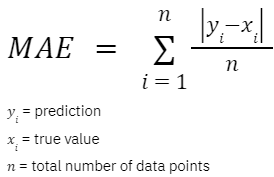When working on a machine learning project, choosing the right error or evaluation metric is critical. This is a measure of how well your model performs at the task you built it for, and choosing the correct metric for the model is a critical task for any machine learning engineer or data scientist. Mean Absolute Error or MAE is a metric commonly used for regression problems.
For Zindi competitions, we choose the evaluation metric for each competition based on what we want the model to achieve. Understanding each metric and the type of model you use each for is one of the first steps towards mastery of machine learning techniques.
Mean Absolute Error is a metric that measures the average magnitude of errors between predicted and actual values. It calculates the absolute difference between each predicted value and its corresponding actual value, and then averages these differences. MAE provides a straightforward and intuitive measure of how close the predictions are to the actual values, without considering the direction of the errors.

MAE is less sensitive to outliers compared to other error metrics such as Mean Squared Error (MSE). Since it takes the absolute difference, extreme values have less influence on the overall error. This makes MAE a suitable choice when dealing with datasets that contain outliers.
For example MAE is a suitable choice in financial forecasting, where overestimating or underestimating values has equal consequences, MAE provides a balanced evaluation of the model's performance.
If you want to penalize larger errors more heavily, consider using MSE or RMSE. These metrics give more weightage to larger errors, which might be suitable when small errors are tolerable but large errors are highly undesirable.
In certain cases, small errors may have a significant impact on the task at hand. In such situations, metrics that amplify the effect of smaller errors, such as Mean Percentage Error (MPE) or Mean Absolute Percentage Error (MAPE), can provide a more comprehensive evaluation.
With this knowledge, you should be well equipped to use MAE for your next machine learning project.
Why don’t you test out your new knowledge on one of our knowledge competitions that uses MAE as its evaluation metric? We suggest the Tanzania Tourism Prediction.